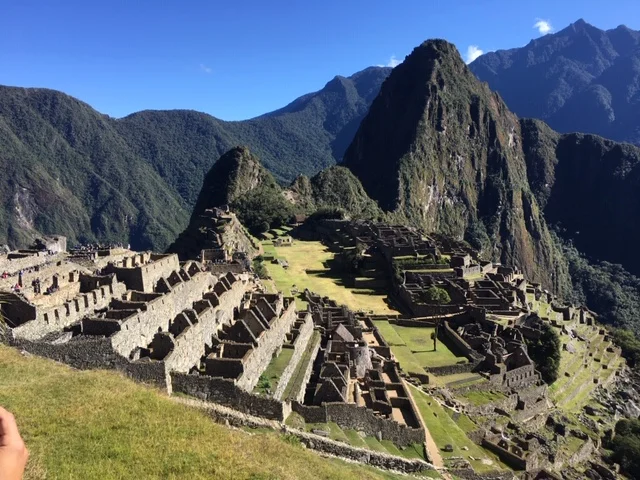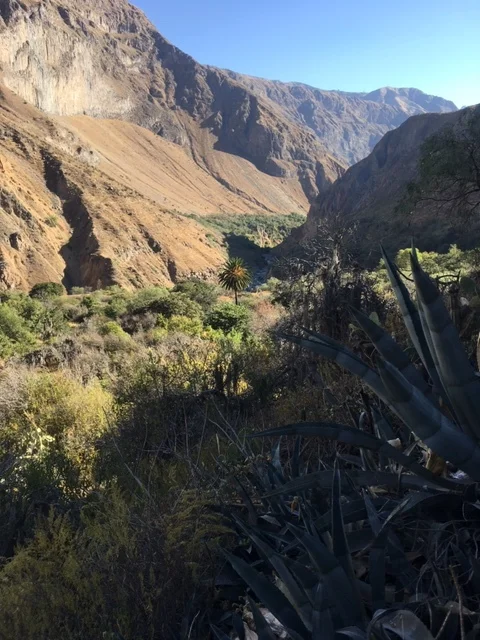Travel Blog Peru - Cusco and the Sacred (Inca) Valley (19th - 21st July 2019)
Before we could put our feet into the capital of the Incas, Cusco, (or Qusqu in the Aymara language, one of the indigenous languages still spoken alongside Quechua), the longest permanently inhabited town in Latin America, settled since 1100AD, sitting at a cool 3,400m of altitude, another awe-inspiringly beautiful UNESCO world heritage site and somehow still relaxed despite the 2m tourists a year - we had to digest our Titicaca experience, and the wild and climatically challenging frontier town of Puno that sits on the lake as its gateway.
We had visited the very touristy and well-known ‘floating islands’ enroute to a nightly stay with a local Quechua family on Isla Amantani, one of the ways that Peru does a good job of making tourism somewhat compatible with the indigenous people, and of aiming to share the benefits of the touristic boom with the wider local population.
We were hosted by single mother Norma and her mother, in their modest house on this island of some 800 families, living mostly from subsistence agriculture (quinoa, corn, animal husbandry focused on sheep), and only going once or twice a month by 3-hour boat trip to Puno, the larger town on the shores of Lake Titicaca, which sits at an imposing and breath-depriving 3,800m.
The family was incredibly welcoming, and we enjoyed many moments chatting in Spanish in the kitchen, the only warmish place in the house. Norma was open in discussing her challenges, with her husband having left, her son having to go to the army since she was short of means to afford private university, and having to take care of her elderly mother, whereas she would rather be on the mainland and live a full life.
Hardly any electricity other than from some solar panels, enough to power a few light bulbs and the radio in the kitchen, the only connection to the outsidse world. No internet, no TV, no newspaper, no social life worth mentioning. The girls had never seen such a simple life, such an existence based near-exclusively on subsistence agriculture, and it put Zosia’s studies of economic development into real perspective. After lights out, we spent time talking, telling stories, and sharing experiences, like people must have done in the old days when life was simpler and neither electricity nor internet nor mobile phones allowed distractions such as reading or internet surfing or the like. At night the temperature dropped to negative territory, but the house had no heating, the windows were thin as paper, and despite three heavy woolen blankets and sleeping in full clothes with hats and gloves on, it was one of the coldest and longest nights I can remember.
[I had first experienced subsistence agriculture in Mexican Chiapas and in Nicaragua in 1987, and in Guatemala in 1991, and despite its challenges still found it a form of poverty that beats the dignity-deprived utter desperation of urban poverty in Indian megalopolis like Delhi, which I visited for the first time in 1992, with self-mutilated begging children and people sleeping on sidewalks by the dozen a culture shock that was to stay with me for a lifetime. So long as people are living in their societies, can by and large maintain themselves, have their support networks of families and neighbours, and maintain their traditions and beliefs, poverty may be an economic challenge but does not – in my reading – deprive many of these people of a sense of purpose and pride, something I found shockingly absent in the urban poverty of Indian megacities.]
We were thus somewhat relieved to leave Puno for what we expect to be the highlight of our trip. The key words in Cuzco and the Sacred Valley of the Incas must be ‘andenes’, Spanish for (mountainous agricultural) terraces, and ‘chakana’, Quechua for the Inca cross, the Cruz del Sur / Southern Constellation of the stars, and a metaphysical bridge between three worlds, the Hana Kacha (the world inhabited by the Gods), the Kay Pacha (our everyday world), and the Urin Pacha (the underworld inhabited by the dead and ancestors); the hole through the centre of the cross is intended to allow to move between these worlds, a bridge between the universes (see image below).
There are many controversies about Inca history, which was largely written by the conquistadores, many of which were uneducated adventurists from Estremadura. Our eloquent and fascinating guide to the Sacred Valley of the Incas, David, a local Quechua, had strong views on the long traditions and superior societal qualities of the Incas, and the miswriting of Incan history by the Spanish and subsequent historians and social anthropologists. His insights into the traditional beliefs of the Incas, their superior agricultural organization of irrigated terraces, where people worked 3 months out of 12 for the wider society to ensure communal food supply, their astrological, meteorological, irrigational, natural medicinal, mathematics, alimentation and construction skills (e.g., moving stone slabs weighing up to 120 tons without the use of the wheel, unknown to them, and without horses or other major draught animals), was mesmerizing.
We had a chance to visit the incredible former Inca fortresses and archeological sites at Ollantaytambo, and at Pisac, both impressive in their architectural sophistication, which served both agricultural and defensive principles, carved into mountains and having sustained dozens of earthquakes over the last 500+ years without crumbling, unlike many of the Spanish Baroque churches and palaces built on top of the Incas’ religious sites, often using the same stones and boulders, to affirm European superiority (similar to Mexico, where the same happened to the Aztec temples).
David extolled to us the virtues of the communal society of the Incas, based on four principles:
1. Ayni (reciprocity and sharing among members of the community), represented by the llama
2. Munay (love), represented by the serpent
3. Yachay (knowing, intelligence, wisdom), represented by the condor; and
4. Ilank’ay (work, effort), represented by the puma.
The girls listened attentively, and somewhat skeptically, as he weaved that compelling interpretation of the ancient culture -- many of its impressive achievements we had a chance to witness -- into a smooth modern Marxist interpretation of Latin American social and economic history, which is still widespread in this subcontinent, and which is well represented by a 1971 book read and revered by many of my Latino friends growing up with that school of thinking, Uruguayan journalist Eduardo Galeano’s ‘Open Veins of Latin America’; it is, of course, also the theoretical underpinning of many leftwing populist governments across Latin America from time to time, with the Venezuelan fiasco of Chavez/Maduro and the decade of Kirchnerismo in Argentina just two recent examples (and my friends will argue that the opposing, market-friendly, ‘neoliberal’ policies have only exacerbated poverty and inequality).
This discourse is far from theoretical here, and has a direct bearing on nearly all Latin American countries over the last century, being at the core of the debate on how to overcome the legacy of unequal income distribution, feudal property relations imported from Spain, latifundismo and lack of agricultural reforms, limited social mobility and narrow middle classes making for unstable politics, as well as the widespread rent-seeking and corruption by the ruling classes. But that is for another discussion.
[Meanwhile, ‘la nina mala’ has been growing up. Vargas Llosa fast forwards to Paris in the early 1960s, where his narrator, now a graduated Peruvian lawyer finally in the town of his dreams, making ends meet as a part-time translator at the Unesco and being suspected of secretly writing poetry (to which he has not owned up yet, but autobiographic parallels to Vargas Llosa are unmistakable), mingles with revolutionary Latino wannabees, fascinated by the Cuban revolution, and plotting to bring the same revolutionary solution to Latin America’s intractable problems of extreme inequality, ebbing and flowing of military dictatorships, and lack of sustained integrative development. His Chilean teenage love Lucy, who – having been exposed as a fraud by the petit bourgeois society of Miraflores and having left his life around 15 – reappears in Paris on a ‘revolutionary scholarship’ enroute to Cuba, as ‘guerrillera Arlette’. He declares his love a 4thtime, and recites Chilean noble literate Pablo Neruda’s love poem ‘Material Nupcial’ (Bridal Material) to her in his little Parisian mansard before finally making love to her, at the age of 25. She is cold and less romantically inclined, and begs to go beneath the sheets while he recites this complex and erotic poem to her from memory:
https://www.babelmatrix.org/works/es/Neruda,_Pablo-1904/Material_nupcial/en/55013-Nuptial_Substance
After finally seeing his teenage love fulfilled, he is thrown into emotional turmoil upon seeing her disappear to Cuba for what was supposed to be a short three months, only to see her come back three years later, married, arriviste and froid, to an ageing French diplomat … and although he then becomes her lover, he never conquers her love, nor is he alone in desiring her female attributes and her heart, going from one suffering episode to another in the city of his dreams … Having finally fulfilled his life-long dream of spending an entire night with her, upon pressing her to divorce the diplomat and marry him, she brusquely tells him:
“Que ingenuo y que iluso eres. No me conoces. Yo solo me quedaría para siempre con un hombre que fuera muy, muy rico y poderoso. Tu nunca lo seras, por desgracia.” (You are disgenious and full of illusions. You don’t know me. I would only stay forever with a man who would be very rich and powerful. You will never be that, unfortunately.)
As if that were not enough to break his heart, she shortly thereafter disappears without a trace, having emptied her husband’s offshore Swiss bank account, leaving them both alone over a Parisian dinner guessing what is true and what is made-up in her many stories and narratives … meanwhile some of his close Peruvian Parisian friends, all revolucionistas, have tried to set up a Che Guevara-like guerrilla operation in the Peruvian sierra, only to end as miserably dead as the great Argentinian medical student-turned-guerrilla himself, in his abortive Bolivian revolutionary exploits, in 1967, aged 39. His malaise could not be more complete.]




















